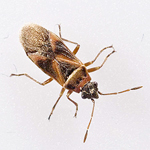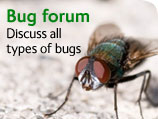Mystery insect found in Museum garden
An insect not seen in the UK before was discovered living in the Natural History Museum's Wildlife Garden in spring 2007.

This new insect has made its home on the plane trees around the Museum
The tiny bug baffled insect experts at the Museum who were trying to identify the mystery newcomer.
The almond-shaped bug is red and black and about the size of a grain of rice. The bug appears to be harmless, but there is potential for it to spread throughout the UK.
Living on London plane trees
The bug was first seen in the Museum grounds in March 2007 on the seeds of some of the plane trees that grow there. There were also similar specimens found in other parts of London in 2006 that other scientists reported in a paper in May 2007.
The insects in the Museum grounds increased in numbers so quickly that by August 2007 it was the most common insect in the Wildlife Garden.
'It seems strange that so many of these bugs should suddenly appear,' says Max Barclay, one of the Museum's insect experts.
'With international trade and climate change, several new insects are showing up in London every year. Some of the invaders come from southern Europe, but others are from as far away as Australia. The fauna of the city is changing all the time now.'
Not even one in 28 million
Experts checked the new bug with those in the Museum's national insect collection of more than 28 million specimens. Amazingly, there was no exact match.
From alder to plane trees?

This mystery bug has not been seen in the UK before. It is an immature specimen, which is why it looks slightly different to the adult above.
The bug closely resembles the fairly rare species Arocatus roeselii, which is usually found in central Europe. However, the roeselii bugs are brighter red than this new bug and they are usually associated with alder trees rather than plane trees.
However, the National Museum in Prague discovered an exact match to the mystery bug in their collections - an insect that was found in Nice and is classified as Arocatus roeselii.
'There are two possible explanations,' explains Barclay. 'That the bug is roeselii and by switching to feed on the plane trees it could suddenly become more abundant, successful and invasive. The other possibility is that the insect in our grounds may not be roeselii at all.'
Continued research
The Museum is working with international colleagues to analyse the bug's body shape, form and DNA to see whether it is a newly discovered species or if it is in fact Arocatus roeselii.
Have you seen this bug in your area?
Let us know if you have seen the mystery insect in your area. Discuss the bug, send in pictures and read other people's comments in the Bug forum.
Museum insect experts are waiting to reply to your forum posts and they can help you identify the creatures you find in your house and garden, whether it's the mystery bug or any other insect. Find out now.
Toolbox

The first collected specimen of Theobroma cacao, the plant from which chocolate is made, is kept in the Museum.
